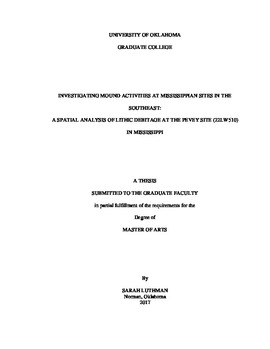| dc.description.abstract | The Pevey site on the Pearl River in Mississippi is a large, multi-mound site from the Mississippi Period (1200-1600 A.D.). Relatively unstudied compared to other large mound sites in the Southeast, Pevey’s distinctive U-shaped configuration of mounds of various sizes has led some to question whether its layout could have been a reflection of the social organization of the people who constructed and lived on these mounds. Previous ceramic analyses (Livingood 2006) have determined that there might be differences in the activities on each mound, and an additional lithic analysis here will further illuminate how these mounds might have been used during the Winstead Phase (approximately 1100-1350 A.D.).
Comparisons are made to previous research on mound use at other sites in the Southeast, including Moundville to the east and Plaquemine multi-mound sites to the west, to determine the significance of the U-shaped configuration, and how we might see a difference in lithic materials at the largest mounds which may have been used for elite activities. Upon examination, the lithic assemblage densities on the northern row of mounds were significantly less than the southern row densities. While this could be a factor of proximity to the Citronelle gravel cobbles in Mill Creek, it could also suggest the site was used by two corporate groups, each occupying its own row of mounds. Although there were also similarities between some of the smaller mounds, clusters do not suggest an alternative pattern of pairs across the open plaza. Finally, the largest mounds of the Pevey site do indeed show lithics that are slightly different than assemblages from other excavation units. These site asymmetries are similar to models created for Archaic shell mound sites in the Southeast, and could suggest that pre-contact people from many different time periods physically elevated their leaders in similar ways. | en_US |
